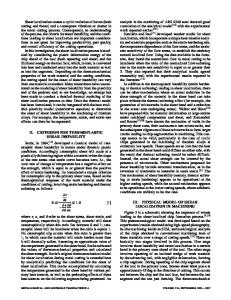Cutting Edge Influence on Machining Titanium Alloy
- PDF / 1,042,092 Bytes
- 12 Pages / 595.276 x 841.89 pts (A4) Page_size
- 40 Downloads / 415 Views
Cutting Edge Influence on Machining Titanium Alloy Konrad Wegener* Institut f€ ur Werkzeugmaschinen und Fertigung (IWF), ETH Z€urich, Z€urich, Switzerland
Definition The performance of machining titanium can be enhanced by using cutting tools with rounded cutting edges at adapted cutting speed and feed. The rounded cutting edges influence the active force components including plowing forces and tool face friction, which are especially important in machining titanium alloy as Ti–6Al–4V. Methods to correctly determine the cutting edge radius are prerequisite for this analysis as well as methods to prepare cutting edge geometry in a controlled way. The state of the art is mainly described in Wyen and Wegener (2010) as well as in Wyen et al. (2012).
Theory and Application Introduction Titanium is classified as a difficult-to-machine material. Its mechanical and chemical properties cause high wear on cutting edges. By preparing cutting edges with defined rounding, initial crack formation can be reduced, the mechanical strength of a cutting edge can be improved, and the load on the cutting edge is changed. Different researchers prove an enhancement of the tool life when using cutting tools with rounded cutting edges (Bouzakis et al. 2002; Rech et al. 2005; Denkena et al. 2008). The optimal cutting edge radius for a machining process depends on the work material and tool material including its coating and machining conditions. Generally, total forces recorded in a cutting process are the sum of forces acting on the tool flank and its cutting edge, as well as on the face. The force acting directly on the cutting edge is called plowing force FPl; see Fig. 1. It originates from elastic and plastic deformation of the work material around the cutting edge. The plowing force is also referred to as parasitic force or zero-feed force (Albrecht 1960; Stevenson 1998; Guo and Chou 2004). In literature, different methodologies exist to reveal the plowing force (Albrecht 1960; Stevenson 1998). Its determination and separation from the total forces allows a better understanding of tool wear and shearing process and enables the determination of actual coefficients of friction in a cutting process. The analysis of these forces in machining titanium alloy needs to be done for different cutting edge radius rn, cutting speed vc, and feeds f.
Cutting Edge Characterization As essential precondition, such analysis needs precise cutting edge preparation and characterization method featuring high repeatability. Currently available characterization methods for rounded cutting edges are often found to be not repeatable. A recent survey (Denkena 2008) comparing the cutting edge radius measurement at different institutions shows significant deviations in the determined radii. No international standard yet exists that defines how the micro-geometry of a cutting edge profile has to be *Email: [email protected] Page 1 of 12
CIRP Encyclopedia of Production Engineering DOI 10.1007/978-3-642-35950-7_16677-5 # CIRP 2015
rake direction of cutting
Y
ro
Data Loading...











